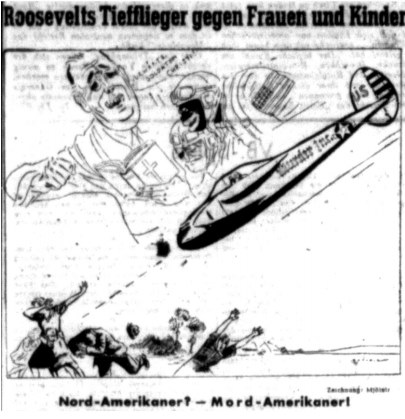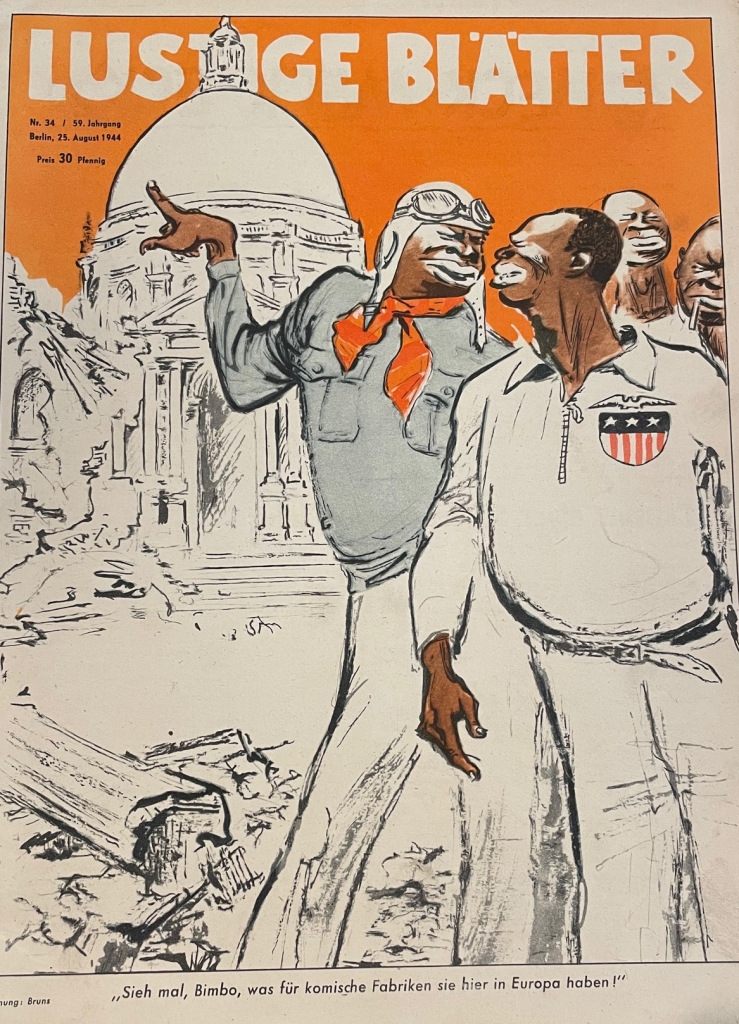African Americans held a distinctive place in wartime propaganda aimed at a domestic audience. While they could serve as a symbol of victory, as in this newsreel footage (see 3:30-4:30) focusing on Black POWs, they were also used to criticise America’s alleged inadequacies. Drawing on racial theories and tropes drawn from anti-Rhine occupation propaganda, Black soldiers were held accountable for all imaginable social ills, particularly sexual transgressions against innocent girls and women. Image 1 from Kladderadatsch, for example, constructs a deviant and threatening Black sexuality by conveying the grotesque corporeality of the Black figure. It not only emphasizes his racial degeneracy but also taps into German fears of rape and miscegenation through the stark contrast to the beautiful white woman.
War propaganda also used African-American figures to call out America’s deplorable practice of using a subjugated race to fight for “democracy.” In image 2 from the Lustige Blätter, African-Americans were used to both convey the alleged inadequacies of capitalism and democracy, as well as to criticise America for relying on “undesirables.” The fat white politician offers money to the Black men, caricatured as uncivilized savages: “Hey Boy, come here! If you come and fly for us, you’ll get to shoot at white women and children!” In both images, the US was thus depicted as a country of devastating racial miscegenation, resulting in a people without identity, biological quality, and spiritual unity.
Furthermore, the Nazi regime utilised its portrayal of African-American airmen to construct an environment that promoted active participation. Propaganda and personal experiences with bombing greatly influenced the hostility of German civilians, leading to the mistreatment of downed American airmen, identified as “lynch justice” (Lynchjustiz). In particular, satirical Nazi magazines became critical in depicting American airmen as the key symbol of American savagery. As seen in image 3, an illustration from the Völkischer Beobachter, Nazi propaganda used pejorative euphemisms for (often African-American) airmen like “terrorist pilot” (Terrorflieger) or “sky gangster” (Luftganster) and “child murderer” (Kindermörder). Due to the provocative nature of these euphemisms, they should be seen as an incitement by the Nazi regime to induce the German population to partake in brutal atrocities against airmen.
The regime portrayed such acts of vengeance as morally rational, particularly when linking American savagery to alleged wrongdoings towards white woman and children, as seen in image 4 from Lustige Blätter. Alongside supposed striking of “soft targets,” African-American airmen were portrayed as targeting sites of cultural and historical significance, further signalling American (Black) impurity and “soullessness” (Seelenlosigkeit) as seen in the poster from the Lustige Blätter. These racialized propaganda images of the degenerate African-American soldier were an effective tool to foster state-sponsored lynch justice.
By vilifying African-Americans, propagandists hoped to capitalize on pre-existing beliefs in German society on race, culture, and modernism. The image of the African-American soldier became intrinsic to Nazi efforts to demonize Germany’s enemies and to promote loyalty to Hitler and patriotic involvement on the home front.
Niamh Neville
Sources:
Image 1: “Die Lady im Zweifel,” Kladderadatsch vol. 96, no. 14 (April 1943): 236.
Image 2: “Der Glücksbote aus USA,” Lustige Blätter vol. 58, no. 33 (13 August 1943). Courtesy of Randall Bytwerk and the German Propaganda Archive.
Image 3: Völkischer Beobachter (14 June 1944). Courtesy of Kevin T. Hall.
Image 4: “Sieh mal, Bimbo,” Lustige Blätter vol. 59, no. 34 (25 August 1944). Courtesy of Randall Bytwerk and the German Propaganda Archive.
Black GIs in German home front propaganda (1943-1944) by Niamh Neville is licensed under a Creative Commons Attribution-ShareAlike 4.0 International License. Permissions beyond the scope of this license may be available at https://blackcentraleurope.com/who-we-are/.



